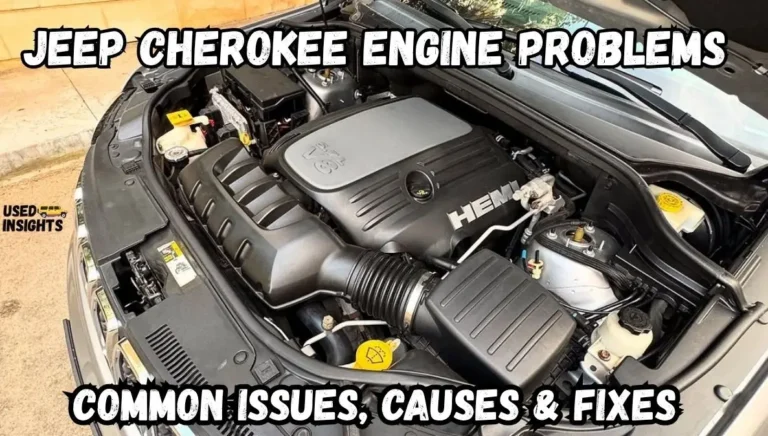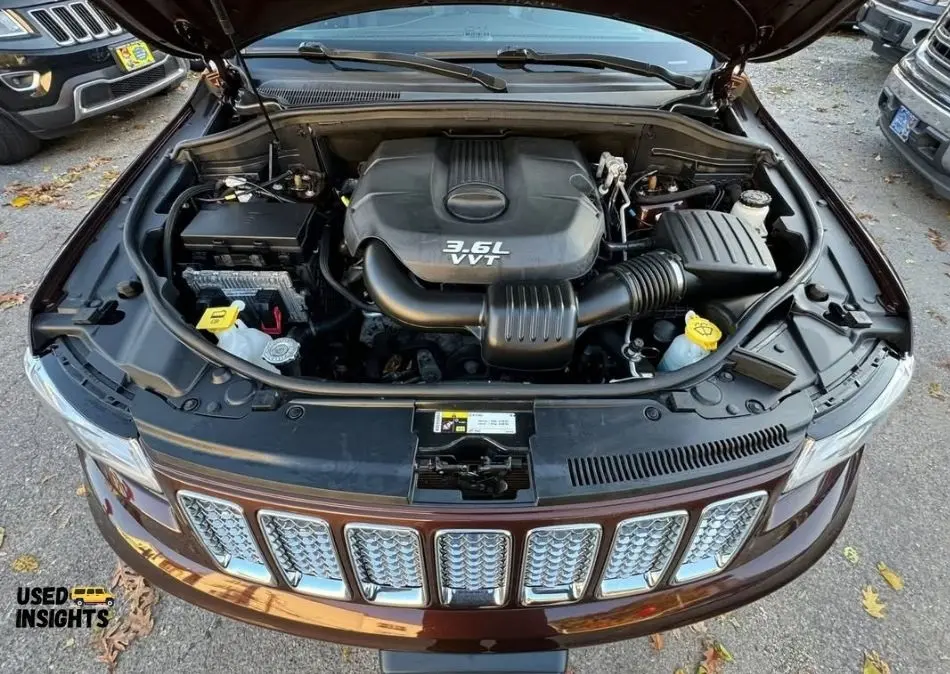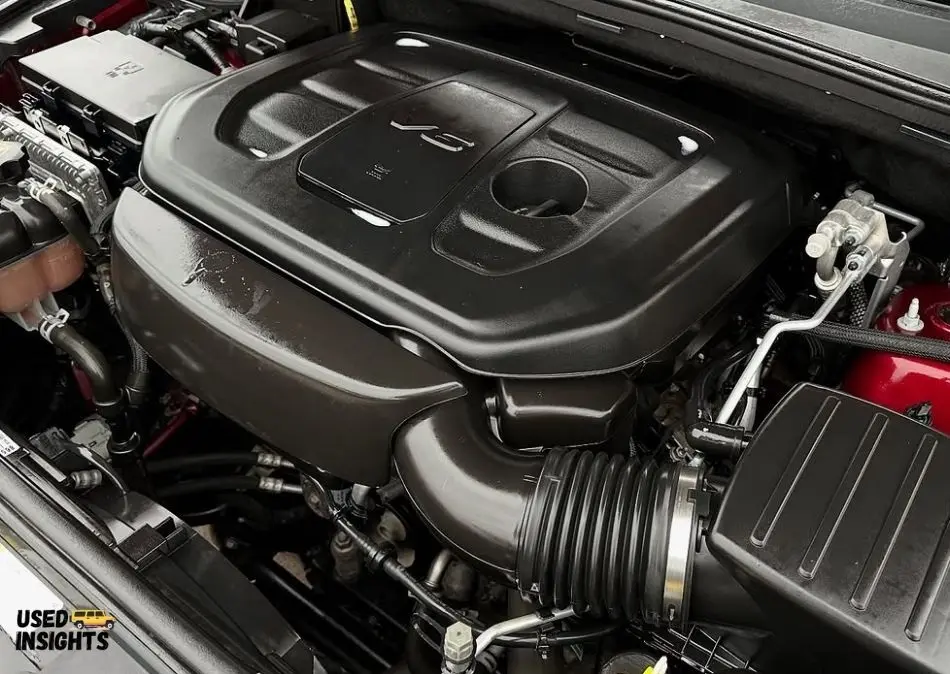The Jeep Cherokee stands as an iconic Sport Utility Vehicle that first rolled off production lines in 1974 as a derivative of the legendary Jeep Wagoneer. Chrysler initially developed this Cherokee variant as a comprehensive SUV solution, drawing its name from the respected Native American Cherokee tribe.
This blog will guide you through a detailed outline about all Jeep Cherokee Engine Problems, specifically for 2015, 2019 and 2021 models.
The vehicle quickly gained recognition for delivering exceptional off-road performance and providing drivers with confidence-inspiring capability across challenging terrain. Production of the Jeep Cherokee concluded in February 2023, marking the end of an era that spanned nearly five decades. Throughout this extensive production run from 1974 to 2023, manufacturers released five distinct Cherokee generations.
However, automotive enthusiasts have reason for optimism, as Jeep has announced plans to resurrect the Cherokee nameplate with a new SUV series launching in 2025, representing what will be considered the sixth generation of this beloved model.
Jeep Cherokee Engine Configuration Overview
The Cherokee’s 49-year production history encompasses five distinct generations, with Chrysler engineering teams developing diverse engine options for each evolutionary phase. Below is a comprehensive breakdown of every generation’s powerplant offerings:
First Generation SJ (1974-1983) Powerplant Options
The inaugural Cherokee generation featured robust American-built engines:
- 4.2-liter AMC inline-six (gasoline)
- 5.9-liter AMC V8 (gasoline)
- 6.6-liter AMC V8 (gasoline)
Second Generation XJ (1984-2001) Engine Lineup
This generation marked Cherokee’s expansion into international markets with diversified engine options:
- 2.1-liter Renault J8S turbodiesel inline-four
- 2.5-liter VM Motori 425 OHV turbodiesel inline-four
- 2.5-liter AMC inline-four (gasoline)
- 2.8-liter GM LR2 V6 (gasoline)
- 4.0-liter AMC/PowerTech inline-six (gasoline)
Third Generation KJ (2002-2007) Engine Selection
The third-generation Cherokee introduced modern engine technologies:
- 2.4-liter PowerTech inline-four (gasoline)
- 2.5-liter VM Motori R 425 inline-four (turbodiesel)
- 2.8-liter VM Motori R 428 inline-four (turbodiesel)
- 3.7-liter PowerTech V6 (gasoline)
Fourth Generation KK (2008-2013) Powerplant Options
This generation streamlined engine offerings while maintaining performance capabilities:
- 2.8-liter VM Motori RA 428 inline-four (turbodiesel)
- 3.7-liter PowerTech V6 (gasoline)
Fifth Generation KL (2014-2023) Engine Portfolio
The final Cherokee generation showcased advanced engine technology:
- 2.0-liter Multijet inline-four (diesel)
- 2.0-liter GME T4 Hurricane inline-four (gasoline)
- 2.2-liter Multijet inline-four (diesel)
- 2.4-liter Tigershark inline-four (gasoline)
- 3.2-liter Pentastar V6 (gasoline)
Beginning with the second generation, FCA strategically offered both gasoline and diesel powerplants. Diesel engines became renowned for delivering exceptional torque output and fuel efficiency, while gasoline variants earned praise for quieter operation and refined driving dynamics.
Six Primary Jeep Cherokee Engine Complications and Remedies
Cherokee ownership experiences have revealed recurring engine complications spanning multiple model years. While some issues present minor inconveniences with straightforward solutions, others demand extensive repairs or complete engine reconstruction.
Six predominant problems consistently emerge across Cherokee model years: engine fluid seepage, cylinder combustion irregularities, ECU malfunctions, unexpected engine shutdown, excessive heat generation, and elevated fuel consumption patterns.
1. Engine Oil Seepage Problems
Numerous Cherokee operators have encountered oil leakage complications affecting their vehicles’ powerplants. Documentation shows 14 specific model years experiencing this issue, including the 1990-2001 range plus 2015 and 2016 models. Statistical analysis indicates Cherokee engines typically develop oil seepage after accumulating approximately 163,300 miles of operation.
Identifying Symptoms:
- Distinctive burnt oil odor permeates vehicle cabin
- Noticeable decline in overall engine performance
- Visible oil puddles beneath parked vehicle
Root Causes:
Oil seepage primarily occurs through compromised valve cover gaskets or damaged oil pan components. Additionally, deteriorated timing cover gaskets frequently contribute to oil leakage complications.
Repair Solutions:
Addressing gasket failures requires complete component replacement to eliminate oil seepage. Valve cover gasket replacement typically costs up to $475 including professional labor charges. Oil pan gasket replacement expenses can reach $780 maximum. These estimates exclude applicable taxes and additional fees.
2. Cylinder Combustion Irregularities
Engine misfiring typically manifests after vehicles accumulate approximately 67,700 miles of operation. This represents one of the most significant and frequently reported Cherokee engine complications, with 2001 and 2015 model years experiencing particularly high incident rates.
Warning Indicators:
- Check engine warning light activation
- Diagnostic misfire error codes generation
- Irregular idle patterns and rough engine operation
- Reduced overall engine efficiency and power output
- Noticeable engine vibration and shaking
Underlying Causes:
Ignition system component failures, including damaged spark plugs, faulty ignition coils, or compromised ignition wiring, typically trigger cylinder misfiring. These component failures can potentially escalate into complete cylinder system breakdown.
Corrective Measures:
Initial spark plug or ignition coil replacement often resolves misfiring at preliminary stages, with repair costs reaching $600 maximum. However, complete cylinder failure scenarios require comprehensive cylinder head replacement, potentially costing up to $4,000 for parts and labor.
3. Engine Control Unit Malfunctions
The Engine Control Unit serves as the central command system governing critical engine operations, including valve timing coordination, fuel delivery management, compression ratio maintenance, and spark timing control.
ECU failures create cascading problems throughout engine systems. Statistical data indicates ECU failures typically occur after approximately 52,840 miles of operation, with 1990 and 2017 model years showing elevated failure rates.
Diagnostic Symptoms:
- Sudden, unexpected engine shutdown
- Check engine warning light illumination
- Diagnostic trouble codes appearing during OBD2 scanning
- Vehicle startup failures from parked positions
- Cylinder misfiring episodes
- Deteriorated fuel economy performance
- Increased exhaust emissions output
Also can check Jeep Cherokee Loses Emissions Convection OBD2
Failure Mechanisms:
ECU malfunctions often result from compromised electrical connections or wiring harnesses. Engine overheating events, water intrusion damage, and internal software corruption also contribute to ECU failures. Minor software-related issues may respond to ECU reprogramming, while hardware failures require complete unit replacement.
Resolution Strategies:
Initial software updates and reprogramming may resolve minor ECU glitches. Severe hardware failures necessitate complete ECU replacement, with new units costing up to $520 plus labor charges not exceeding $130.
4. Unexpected Engine Shutdown
Multiple Cherokee owners report experiencing sudden engine stalling during operation. These incidents involve vehicles starting normally but unexpectedly shutting down during driving or failing to restart after parking. Engine stalling while driving creates dangerous situations potentially threatening driver and passenger safety.
This complication affects virtually all Cherokee model years, with notable incidents reported in 1987-1989, 1993, 1994, 1996, 1999, 2014-2019, and 2021 models. The 2014 and 2016 model years demonstrate particularly high stalling incident rates. Engine stalling symptoms typically emerge after approximately 1,000 miles of operation.
Observable Signs:
- Unexpected transmission shifts to neutral during driving
- Sudden engine shutdown without preceding warning indicators
- Startup system failures
- Engine warning light activation
Causal Factors:
Defective spark plugs commonly trigger engine stalling episodes. Damaged ignition coils or contaminated air filtration systems also contribute to stalling problems. Industry reports specifically link 2019 Cherokee stalling issues to defective nine-speed transmission systems.
Remedial Actions:
Initial troubleshooting should verify adequate fuel levels, as low fuel commonly causes similar symptoms. Comprehensive diagnostics should examine spark plug condition – blackened plugs require immediate replacement at approximately $20 excluding labor costs.
Ignition coil testing using multimeter equipment helps identify faulty components, with replacement costs not exceeding $100 for parts only. Air filter cleaning or replacement may resolve contamination-related stalling. Complex transmission-related stalling requires professional dealership diagnosis and potential warranty claims.
5. Engine Temperature Regulation Failures
Engine overheating represents another widespread Cherokee complication affecting numerous model years. Temperature regulation problems typically develop after vehicles accumulate 220,000 miles of operation. While overheating causes vary significantly, diagnosis and repair procedures remain relatively straightforward.
Temperature Warning Signs:
- Vehicle temperature gauge readings exceeding normal ranges
- Check engine warning light activation
- Coolant contamination in fuel system
- Noticeable engine performance deterioration
Heat Generation Causes:
Coolant system leakage represents the primary overheating cause, preventing adequate engine cooling and elevating operating temperatures. Malfunctioning water pumps or thermostats also contribute to temperature regulation failures. Radiator blockages from accumulated debris restrict cooling system airflow, while cracked head gaskets allow coolant-fuel mixing.
Temperature Control Solutions:
Comprehensive vehicle diagnosis should precede repair attempts. Coolant presence in fuel tanks or ground puddles indicates system leakage requiring component replacement. Leak repair costs range from $600 to $2,000 depending on damage severity.
Water pump replacement expenses typically remain below $900, while thermostat and head gasket replacements cost approximately $530 and $2,600 respectively.
6. Excessive Fuel Consumption Patterns
Cherokee model years spanning 2014 through 2021 demonstrate elevated oil consumption patterns, with 2016 and 2017 models showing particularly severe consumption rates. The 2.4-liter Tigershark engine exhibits the most significant consumption issues, resulting in legal action against FCA regarding this powerplant. Excessive consumption symptoms typically emerge after 10,000 miles of operation.
Consumption Warning Indicators:
- Dramatically reduced fuel efficiency ratings
- Low oil pressure warning messages
- Oil sensor activation and warning light illumination
- Burnt oil odors or visible smoke emission
Consumption Root Causes
Fuel system component leakage frequently leads to elevated consumption rates. Legal documentation indicates design defects in 2.4-liter Tigershark engines cause excessive internal oil burning. Alternative engine variants may experience PCV valve or spark plug malfunctions contributing to consumption issues.
Consumption Correction Methods
Initial leak detection and damaged component replacement addresses external consumption causes. PCV valve inspection and replacement costs approximately $200 including labor charges. Vehicles emitting excessive smoke indicate serious internal engine damage.
Spark plug replacement costs approximately $20 for complete service, while extensive engine rebuilding reaches $5,000 depending on internal component condition and required repairs.
2015 Jeep Cherokee Engine Problems
The 2015 Jeep Cherokee, a popular compact SUV, has faced scrutiny for engine-related issues that have frustrated some owners. While praised for its off-road capability and modern design, certain engine problems have been reported, impacting reliability and performance. Understanding these issues can help owners and prospective buyers make informed decisions.
One of the most common complaints involves the 2.4L Tigershark MultiAir 4-cylinder engine, standard in many 2015 Cherokee models. Owners have reported excessive oil consumption, often requiring frequent top-offs between oil changes. This issue can lead to engine damage if not monitored, as low oil levels may cause overheating or internal component wear. Some drivers noted oil leaks, particularly from the oil filter housing, which could exacerbate the problem. Chrysler issued technical service bulletins (TSBs) to address these concerns, recommending inspections and repairs, but not all owners found lasting solutions.
Another prevalent issue is rough idling and stalling, particularly with the 3.2L V6 Pentastar engine option. Drivers reported unexpected engine shutdowns at low speeds or stops, posing safety risks. Software updates to the engine control module (ECM) were released to mitigate this, but results varied. Additionally, some owners experienced transmission-related issues, like harsh shifting, which indirectly affected engine performance due to the integrated powertrain system.
To address these problems, regular maintenance, including timely oil changes and software updates, is crucial. Owners should check for recalls or TSBs through Chrysler or a certified mechanic. While not all 2015 Jeep Cherokees face these issues, staying proactive can prevent costly repairs and ensure a smoother driving experience.
2019 Jeep Cherokee Engine Problems
The 2019 Jeep Cherokee, a popular compact SUV, has garnered attention for its rugged design and off-road capabilities. However, some owners have reported engine-related issues that can affect performance and reliability. Understanding these problems is crucial for prospective buyers and current owners to make informed decisions about maintenance and repairs.
One of the most commonly reported issues with the 2019 Jeep Cherokee involves the 2.4L Tigershark MultiAir 4-cylinder engine. Owners have noted problems such as excessive oil consumption, which can lead to engine wear if not monitored closely. This issue often requires frequent oil top-offs between scheduled changes, and in severe cases, may necessitate engine repairs or replacements. Some drivers have also experienced engine misfires, which can cause rough idling, reduced power, and poor fuel efficiency. These misfires are often linked to faulty spark plugs, ignition coils, or fuel system issues.
Another concern is related to the 9-speed automatic transmission paired with the engine, which can contribute to performance issues. Some owners report jerky shifting or hesitation, which may feel like an engine problem but stems from the transmission’s interaction with the engine. Additionally, there have been reports of stalling or unexpected shutdowns, particularly at low speeds or when idling, posing safety concerns.
To address these issues, owners should adhere to regular maintenance schedules, use recommended oil types, and promptly address any warning lights. Consulting with a certified Jeep technician and checking for recalls or technical service bulletins (TSBs) can also help mitigate these engine problems effectively.
2021 Jeep Cherokee Engine Problems
The 2021 Jeep Cherokee, a popular compact SUV known for its off-road capability and sleek design, has faced scrutiny from owners and critics alike due to reported engine problems. These issues have sparked discussions in automotive forums and prompted some owners to seek repairs or file complaints. Understanding the common engine-related concerns can help current and prospective owners make informed decisions.
One of the most frequently reported issues with the 2021 Jeep Cherokee involves the 2.4L Tigershark MultiAir inline-4 engine, standard in many trims. Owners have noted excessive oil consumption, with some reporting that the engine burns through oil faster than expected, leading to low oil levels between scheduled changes. This can cause engine misfires, stalling, or, in severe cases, long-term damage if not addressed promptly. Some drivers have linked this issue to faulty piston rings or poor engine design, though Jeep has not issued a widespread recall specifically for this problem.
Another concern is the 9-speed automatic transmission paired with the Cherokee’s engines, including the 3.2L V6 and 2.0L turbo. Drivers have reported rough shifting, hesitation, or unexpected power loss, which can feel like engine-related issues. These problems often stem from transmission software glitches rather than the engine itself, but they impact the driving experience. Jeep issued software updates to address some of these complaints, but results have varied.
Additionally, some owners have experienced issues with the start-stop system, which can cause the engine to shut off or restart erratically. This feature, designed for fuel efficiency, has been criticized for being unreliable in certain conditions. While not a catastrophic failure, it contributes to owner frustration.
If you own a 2021 Jeep Cherokee, regular maintenance, including frequent oil checks and timely software updates, can mitigate some of these issues. For persistent problems, consulting a certified Jeep technician or checking for applicable technical service bulletins (TSBs) is advisable. While the Cherokee remains a versatile SUV, these engine-related concerns highlight the importance of thorough research and proactive care for owners.
Additionally, You can also like and, follow us on Pinterest, and Reddit for more updates. Your thoughts and engagement are greatly appreciated and find more info in the Jeep section!




